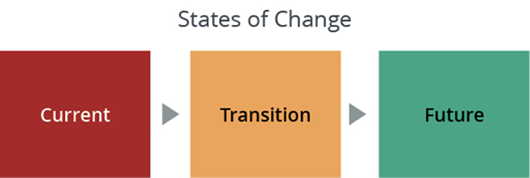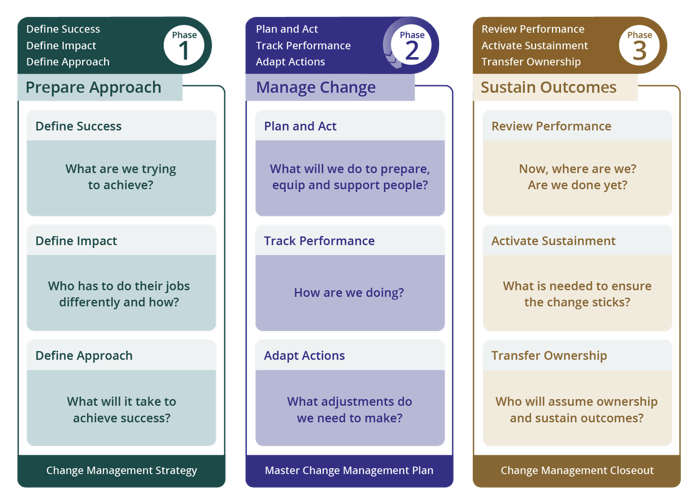Change Management Basics: Glossary

6 Mins
Updated: July 26, 2023
Published: September 26, 2015

Need to improve your change management vocabulary? Here's a brief guide to Prosci change management terms.
General Prosci Definitions
Change management
Change management is the application of a structured process and set of tools for managing the people side of change to achieve a desired outcome.
Organizational change management
When we talk about organizational change management, we are referring to the specific actions and steps that can be taken to implement a change management program. The Prosci 3-Phase Process is an approach for implementing organizational change management.
Individual change management
The process and steps an individual goes through to implement a change successfully, whether personal change or professional change. The Prosci ADKAR Model (Awareness, Desire, Knowledge, Ability and Reinforcement) is one example of an individual change management model that describes the sequence of successful change.
*Change management has been used in the IT world to mean version control or configuration control of software or hardware. In such cases, the change being made is specifically to an IT system. The change management terms above can refer to any type of change at work, e.g. new processes, systems, technologies, reporting structures, products, etc.
Enterprise change management
Enterprise change management (ECM) is the systematic deployment of change management skills, tools and processes throughout an organization. When an organization wants to graduate from using change management on a project-by-project basis, they can deploy change management as a project itself. ECM is comprised of a common set of processes and tools for managing change and leadership competency at all levels of the organization. Ultimately, ECM becomes a strategic capability that equips the organization to be agile, change ready and responsive to marketplace changes.
States of change
Many authors and researchers have broken change down into distinct phases (see Bridge's Transition or Beckhard and Harris's Organizational Transitions). Usually, three distinct phases can be categorized: the future state (how things will be after the change is fully implemented), the current state (how things are today), and the transition state (what will be happening to move from the current to the future states).

Current state
The current state is how things are today. It is business as usual, the processes and tools that make up an employee's daily work. The current state is known and comfortable, and is generally preferred by employees. The current state lays the foundation and context for change management.
Future state
The future state is how things will be. It is unknown, not well understood and fuzzy to employees. Interestingly, the future state is the primary focus of project teams and business leaders who can sometimes overlook the importance of the current state. The future state describes the outcome change management is working to achieve.
Transition state
The transition state is the process of changing the way work is done. For employees, the transition state creates stress and anxiety. It is the 'implementation' phase of a project. The transition state is where change management can minimize resistance and improve how well and how quickly a change is adopted.
Phase 1 – Prepare Approach
This is the first phase in the Prosci 3-Phase Process, which includes defining success, impact and approach, and culminates in a Change Management Strategy. Strategy comes from the Greek word strategia meaning "generalship" or the things generals do as they prepare for battle (i.e., assessing their army's strengths and weaknesses, assessing the enemy's strengths and weaknesses from the scouting reports, assessing the battle field and environment, etc.). During Phase 1 – Prepare Approach, the change management team builds a strategy by assessing the characteristics and readiness of the organizations being impacted, as well as the specific characteristics of the change at hand.
Phase 2 – Manage Change
The second phase in the change management process and includes the tactics the change management team employs to execute the strategy from phase one above. Tactics comes from the Greek word taktika meaning to line up in rows or columns as the soldiers do. This is the execution of the strategy by the soldiers. Depending on the assessments by the generals, the soldiers would either lock shields and go forward in rows (if the enemy was making a stand with swordsmen) or go forward in columns (if the enemy was using archers as their first wave). This is much like the tactics of the change management team based on their strategy developed in preparing for change.
Phase 3 – Sustain Outcomes
The final phase of the change management process focuses on ensuring that changes achieve intended outcomes and people continue to use the changes for the long term without reverting to the old ways of doing things. The word sustain is of Latin origin and comes from the word sustenere, which has several meanings, including to continue or keep up. The work of sustaining outcomes and behaviors from the previous phases includes understanding what the organization needs to do to keep up the changes and who will take ownership before ending change management activities.
The Prosci 3-Phase Process

Change Management Players
Primary sponsor
The primary sponsor is that individual who authorizes and funds the project. This person is usually in control of the resources, systems and people affected by the change. The primary sponsor has three main change management responsibilities, including active and visible participation, coalition building, and communication of business messages about the change.
Sponsor
In general, this term refers to any senior or mid-level manager who has employees that will be impacted by the change, and who must sponsor the change with these employees in order for the change to be a success. Sponsors play a role in building awareness and desire to change with their direct reports, groups, divisions or departments. Sponsor comes from the Latin word sponsus meaning guarantor or one who promises. A sponsor promises or guarantees that they will do everything in their power to make the project a success.
Coach
This role refers to the relationship between a people manager and their employees. A coach is that individual who helps their direct reports transition through the change. In most cases, this role is assumed by front-line supervisors or managers who are directly involved with employees impacted by the change. Coaches are key communicators and managers of resistance. Coach comes from the Germanic word kutsche. There is no one word to describe this person. But it includes: teacher, mentor, advisor, confidant, confessor, and trainer.
Project leader
This role is assigned to that individual who has overall responsibility to implement the project. This individual would have direct day-to-day control over the project team, the project schedule and all vendors associated with the project.
Change management leader
This role is assigned to an individual who will plan and implement change management plans for the project. The change management leader plays a key role in preparing and enabling both 1) senior leaders to be effective sponsors of change and 2) managers and supervisors to be effective coaches.
Leaders
From the Latin word laedo meaning "journey." Change leaders take their people to places they have never been before (i.e., the future state).
Managers
From the Latin word manus meaning "hand." Change managers handle things. They handle budgets, schedules, problems, etc. They do the day-to-day work to make change happen.
Supervisors
from the Latin word super, meaning above or over and visio meaning sight. These are the people managers who "oversee" the operations to make sure (reinforce) that change is and has taken place.
Change Management Plans
The change management plans below are the tools that change managers use to effectively implement change. The goal of each of the plans are to help the individuals of the organization go through the change effectively.
Communication Plan
The communication plan identifies the messages about the change that need to be spread through the organization. These include both the business messages (why the organization is undertaking the change, risks of not making the change, etc.) and the personal messages (how the change impact's a persons day-to-day work). Communication plans should 1) take into account the preferred senders of change messages (hint: there are two); 2) customize messages based on what each specific audience cares about (senior leaders care about much different things than front-line sponsors); 3) utilize a number of different channels (face-to-face is preferred, but be sure to use varied channels); and 4) repeat messages a number of times (don't assume employees will hear what you are saying the first time).
Sponsor Plan
The sponsorship roadmap provides specific details about what the executives and senior leaders need to do to make the change successful. In all four of Prosci's change management benchmarking studies, effective sponsorship was identified as the number one contributor to success. The three high-level responsibilities of the sponsor are active and visible participation, coalition building and communication of business messages about change. The sponsorship roadmap is the document that puts real actions to the role of the sponsor.
People Manager Plan
This plan lays out how managers and supervisors will engage, prepare and equip their direct reports during the change. It includes the actions designed to build support for the change and to communicate personal messages about the change to impacted people and groups on the front lines of the organization.
Training Plan
The training plan details the knowledge that must be built for the change to be successful and the steps to overcome any knowledge gaps that exist. Training covers both the transition state (what do you need to know to be successful during the change) and the future state (what do you need to know to be successful after the implementation). Note that training is effective for building knowledge and ability, but should not be relied upon for building awareness and desire to change.
Resistance Management Plan
This plan lays out the actions for uncovering resistance to the change from impacted people and groups. This includes what the resistance might look like, where it might come from, what steps will be taken to prevent it, and the actions to take when it can not be prevented. This is a proactive effort to address concerns and build support early in the project, rather than waiting until implementation.


